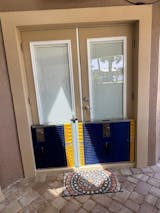Flood control has always been a critical matter for our civilization. Since settling next to rivers, lakes and coastal areas provided people with stable harvest and essential trade and transportation lines, water has also threatened to destroy those settlements in a matter of several hours.

That is why water has such a vivid representation in the folklore of different peoples. Various aquatic spirits, beasts and gods exist in myths and even established religions worldwide. However, they are all united by the same idea - they bring joy and happiness, support life and help people grow their crops, travel, conceal and find treasures. But in exchange, people are required to respect those entities, grant them admiration.
Centuries have passed, and the development of science has proven that floods, typhoons and tsunamis are hardly an act of divine origin but a result of natural events. However, it does not mean that people have no influence on those disasters.
Floods are happening more and more often today. And most of them are caused by global warming and climate change. All those are results of human impact on nature.
Flood control has changed as well. Today it hardly has to do anything with spiritual practices and beliefs. Today`s flood control is a complicated system that constantly develops, adopting innovative techniques and referring to ancient wisdom.
In this article, we shall discuss the 3 most common modern flood control methods, which can be applicable for various properties, combined and adjusted according to your landscape, capability and the threat of flooding in your area.
The three methods of flood control
Technically today, there are 3 available methods to control and prevent floods:
- Planting vegetation that enforces the soil and retains water;
- Building channels that divert floodwater;
- Establishing dykes and barriers, including large-scale and small-scale constructions such as individual flood barriers, sandbagging dykes, etc.
Each of those flood control methods has its strong sides and proven efficiency, along with certain disadvantages.
Using plants for flood control.

People have been using plants for flood control since the dawn of time. Roots enforce the soil and prevent erosion caused by the wash of the sea, and at the same time, they retain groundwaters and keep sands from conquering agricultural fields.
At the same time, there are trees like Eucalyptus that can change the ecosystem entirely, dry swamps and alter the landscape, becoming the most efficient natural flood control.
Once we talk about small-scale flood control with plants, the very fact that you have a garden in front of your house or in the backyard is already an efficient measure to prevent flooding. Unlike tarmac-covered driveways, even the smallest patch of open soil can soak excessive water from heavy rainfall, preventing it from getting into your house.
However, there is a new trend in urban gardening today called Rain Gardens. It includes using plants that help solid soak water most efficiently, provides the least debris that can damage your property in case of flooding and grow best in the areas most prone to floods saving you time and money on maintenance.
Channels, decks and landscape as a flood control measure.

Another popular way to control floods, which is perfectly applicable on all scales, is building channels and other constructions that help derive floodwater away from the property providing maximum protection.
The landscape itself can be why your area gets flooded so often and the solution that can prevent the disaster and its consequences.
Once we talk about a private household, you can combine your Rain Garden with some landscaping changes that would drive water away from your house. Ensure that the land does not form any drenches or pools next to the house or the foundation walls.
You can consider building a deck out of PVC or combined materials, which are resistant to water. Such constructions allow you to raise outdoor furniture, equipment and other belongings above the ground. It saves them from the floodwater itself and prevents them from becoming damaging elements once you deal with massive and destructive flash floods.
Flood barriers and dykes
While the previous two flood control methods were mainly concentrated on the possibility of incorporating flood water, contacting it directly or maybe even benefiting from water access, flood barriers and dikes are built to drive the flood away from your property, blocking any possible contact.
Sandbagging might be one of the oldest and still most available of those flood control methods. It is used on all scales - from national disaster control to protecting private houses and businesses from the water. However, the technologies are moving forward and sandbagging might be still pretty popular but not the most efficient flood control method today.
Temporary flood barriers are righteously called the most efficient ways to protect private houses and businesses from raging water. They come at a standard 3-foot high, which is perfectly enough to withstand a severe flood. At the same time, those barriers are perfectly adjustable for any width of the doorway. Moreover, they can be connected through an extension pole into a long and solid construct action; you own a private unreachable flood dike that will easily withstand the most severe flood and won`t take much storage place once you are done with it.
Contact Dam Easy flood barriers today to learn about innovative, most efficient and modern flood control methods. Our experts will answer all your questions and provide an individual solution that will consider the flood rate of your area, your landscape and the peculiarities of your building.
El dique de contención de inundaciones.

€779,00
Dam easy® para evitar la inundación de la represa. Las inundaciones son cada vez más frecuentes en todo el mundo.Lo que solía ser un fenómeno centenario se ha convertido en una tendencia estacional que los propietarios deben afrontar. … Read More



















